Hanover Bald Eagle Blog # 15 - 2021
April 12, 2021
In partnership with Pennsylvania Game Commission and Comcast Business .
THE HANOVER NESTLING HAS NOW ENTERED THE PHASE OF GROWTH WHEN THEY REQUIRE THE MOST FOOD, CALLED THE PHASE OF “PEAK ENERGETIC DEMAND.” THIS OCCURS 30-35 DAYS AFTER HATCHING, AND TODAY MARKS THE 31ST DAY SINCE HATCH. THE SKELETAL, MUSCULAR, AND NEUROLOGICAL GROWTH OF YOUNG RAPTORS REQUIRES A CONSTANT INFLUX OF NUTRITION-RICH FOOD, AND THEREFORE BREEDING ADULTS HAVE TO MAKE SURE THERE WILL BE ENOUGH FOOD FOR THEIR NESTLINGS DURING THEIR MOST INTENSE PHASE OF GROWTH. FOR BALD EAGLES, THAT MEANS TIMING THEIR BREEDING CALENDARS WITH THE AVAILABILITY OF OPEN WATER, AND CATCHING A LOT OF FISH.
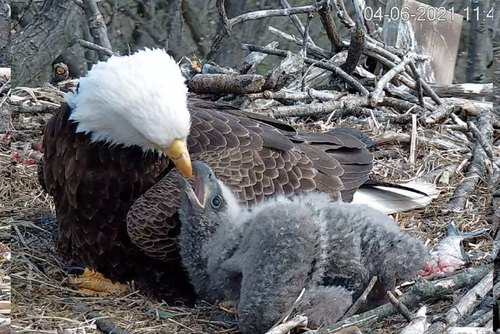
The Hanover nest has become a hotspot for decaying fish, with carcasses often pepperering the outside edges. Nestling bald eagles consume roughly three fish per day in the early stages of their development, and this week we may see that number ratcheted up to four.
Bald eagle nestlings move through a structural growth phase and a feather growth phase before their behavioral growth phase. Right now the Hanover nestling’s feet look disproportionately large (giving them an adorably uncoordinated look), but this is actually normal for bald eagles. The feet and beak reach near-adult size before the rest of their body catches up, likely because they need to use these appendages in the nest. They especially need strong beaks to receive food from their parents and to preen, a behavior they begin soon after preening. During sibling conflict, a nestling eagle may also use the beak to attack or defend.
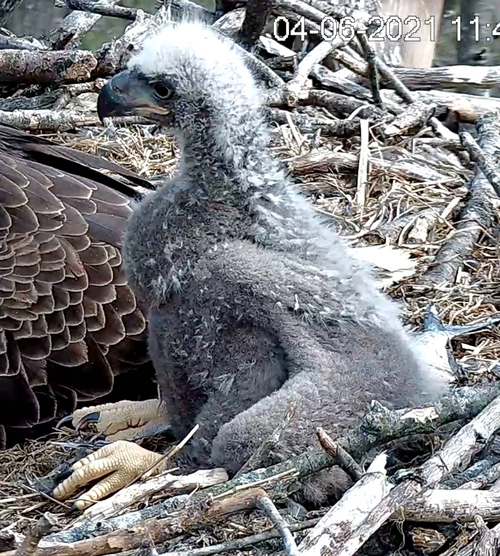
The dark gray layer of down covering the Hanover nestling’s body is called thermal down, and accounts for their ability to thermoregulate without parental help. Feather growth will accelerate in the next two weeks, and before long the nestling will show brown feathers along the humeral tracts which are located on the wings, followed soon after by brown feathers along the head and back.
The behavior of the Hanover parents matches their nestling’s growth phase. The following progression is the norm for many raptor parents, with subtle differences depending on species: In the first phase, females (and sometimes males) brood and shade their young almost continuously. In the next phase, the nestling is still fed by the parents but is sometimes left alone, although someone keeps a lookout nearby. In the third phase, once the nestling is fully feathered, both parents focus more on hunting than standing guard and the nestling is often left alone. At that point the nestling will be capable of tearing their own food apart and defending themself against attackers if necessary.
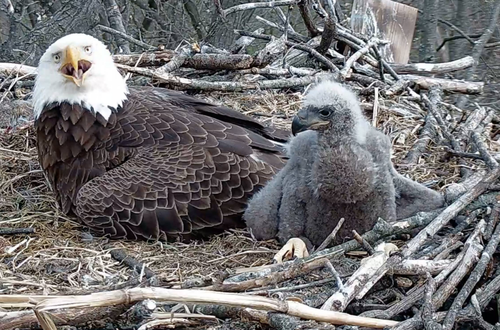
Right now at the Hanover nest, the family is in between phases one and two. Before we know it, the nestling will transition from gray to brown, will grow into its feet, and start exploring the circular confines of the nest with more and more curiosity!
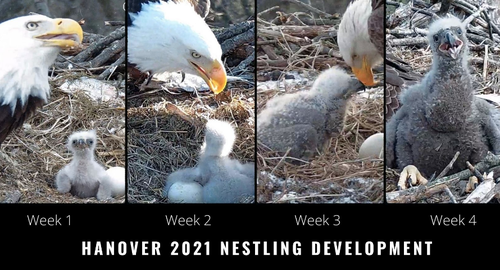
YOUR QUESTIONS ANSWERED:
- There’s no telling if or when the unhatched egg will be removed from the nest. Sometimes eagles bury unhatched eggs, sometimes they nudge them out of the nest, sometimes they eat the egg, and other times they do nothing and the egg simply remains in the nest. Bald eagles don't need to worry about the egg attracting predators, both due to the height of the nest, and the relative lack of predators willing to brave a run-in with three angry eagles. Regardless of what the Hanover family chooses to do with the egg, it doesn't seem to be bothering them or preventing the nestling from growing up strong.
- The nestlings are fed the softest parts of prey so that they don’t get hard morsels stuck in their crops.
- There is speculation that raptors transfer saliva to hatchlings to provide them with enzymes and antibodies that boost their immune system. However, there is not a lot known about this interesting behavior.
- Growth rates of raptors depend on several factors including sex and species. Smaller raptor species like falcons grow faster than larger ones like bald eagles. Male raptors across most raptor species are typically smaller than females, and therefore grow faster than females. This difference in size between male and female raptors is called “reverse sexual size dimorphism.”
Sources
Bildstein, Keith L. (2017). Raptors: The Curious Nature of Diurnal Birds of Prey. Cornell University Press.
Bortolotti, Gary R. (1984). Physical Development of Nestling Bald Eagles with Emphasis On The Timing of Growth Events. Wilson Bulletin, 96(4), 524-542. usask.ca/biology/bortolotti/pubs/wb96-4-524-542.pdf
The Center for Conservation Biology. (2020). Facts About Bald Eagles. https://ccbbirds.org/what-we-do/research/species-of-concern/virginia-eagles/facts-about-eagles/#:~:text=Q%3A%20Why%20do%20eagles%20eat,get%20caught%20in%20their%20crops.
Newton, Ian. (1979). Population Ecology of Raptors. T & A D Poyser Ltd.
ATTENTION HANOVER EAGLE VIEWERS - We recognize that over the years this bald eagle pair has been named by the public and is commonly referred to as "Freedom" and "Liberty". While we understand that naming the eagles helps connect and distinguish the female from the male eagle, naming the pair introduces an element of domesticity to wild animals. In order to respect the eagles and focus on their natural history, we will refer to the female and male as such as per recommendations of the Pennsylvania Game Commission.
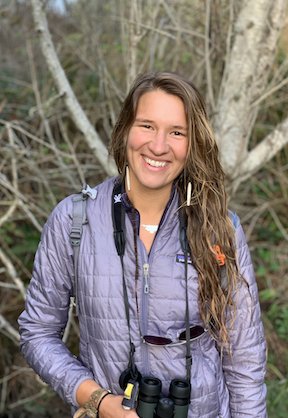
RAPTOR ECOLOGY SPECIALIST - ZOEY GREENBERG
RETURN TO HANOVER BALD EAGLE BLOGS
WATCH THE HANOVER BALD EAGLE LIVE CAMS
For over 20 years, HDOnTap has provided live streaming solutions to resorts, amusement parks, wildlife refuges and more. In addition to maintaining a network of over 400 live webcams, HDOnTap specializes in design and installation of remote, off-grid and otherwise challenging live streaming solutions. Contact press@hdontap.com for all media needs, including images and recordings.